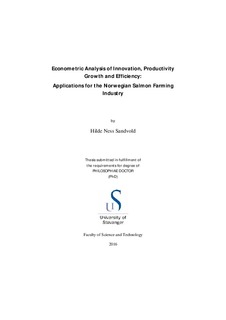| dc.contributor.advisor | Roll, Kristin Helen | |
| dc.contributor.author | Sandvold, Hilde Ness | |
| dc.date.accessioned | 2016-04-20T08:34:45Z | |
| dc.date.available | 2016-04-20T08:34:45Z | |
| dc.date.issued | 2016-02-12 | |
| dc.identifier.citation | Econometric Analysis of Innovation, Productivity, Growth and Efficiency: Applications for the Norwegian Salmon Farming Industry by Hilde Ness Sandvold, Stavanger : University of Stavanger, 2016 (PhD thesis UiS, no. 284) | nb_NO |
| dc.identifier.isbn | 978-82-7644-637-1 | |
| dc.identifier.issn | 1890-1387 | |
| dc.identifier.uri | http://hdl.handle.net/11250/2386422 | |
| dc.description | PhD thesis in Risk management and societal safety | nb_NO |
| dc.description.abstract | Although salmon farming in Norway has a relatively short
history, it has developed into an important export industry
for the national economy. The industry has experienced large
growth in production volume; production has increased from
a few thousand tons in 1980 to over 1.3 million tons in 2014.
An important driver for this development has been extensive
technological improvements and strong productivity growth
leading to reduced production costs and improved
competitiveness. A key feature for cost reduction has been
better and cheaper inputs. After feed, smolt is the most
important input factor in salmon farming. Smolt production
has experienced rapid technological progress since the
industry first stated in the 1980`s. Most of the cost savings
due to productivity increase in juvenile production has been
passed on to the grow-out farms in the form of lower smolt
prices. This has made Norwegian salmon more competitive
relative to other food producers. Hence, salmon farming is an
example of an industry where technological improvements
have led to productivity growth and increased
competitiveness. Norwegian salmon aquaculture provides a
highly relevant case in the study of innovation and economic
growth.
The purpose of this thesis is to highlight the relevance of
innovations in salmon production by measuring their
economic effects. This is addressed by focusing on economic
drivers in the industry using econometric productivity and
efficiency analysis. I have used several measures to
investigate and compare the performance among firms and
regions over time. Among these are productivity growth,
technological change, efficiency and economies of scale. The
econometric analyzes uses translog production and cost
functions to investigate the production technology.
My thesis indicate that the substantial productivity growth in
smolt production has contributed significantly to improved
competitiveness of the salmon industry. However, the results
shows that productivity growth in juvenile production has
slowed down, and actually become negative some years.
Furthermore, the econometric analysis indicate that not all
firms in the industry are operating on the technically efficient
frontier. In this respect, the geographic region for smolt
production matters, since some regions tend to have higher
production costs than others. In addition, the analysis finds
econometric support for the existence of a learning-by-doing
effect in juvenile production, suggesting that older firms
perform slightly better than new ones with respect to
technical efficiency. Finally, an analysis of salmon farming
globally shows that the degree of concentration has
increased in all the five leading producing countries. The large
firms have become bigger over time.
This thesis falls in line with a large collection of economic
research on the Norwegian salmon industry. The literature on
productivity growth in the grow-out phase of salmon has got
substantial attention. However, so far there has been paid
less attention to productivity growth among the suppliers.
Since juvenile freshwater production is crucial for further
sustainable growth, it is my hope that the insights and results
from this thesis will be of interest. Although the results apply
specifically to salmon aquaculture, most aquaculture
producers are exposed to similar types of regional differences
and biological shocks. Therefore, the results of the analysis
should be relevant to other aquaculture species as well. | nb_NO |
| dc.language.iso | eng | nb_NO |
| dc.publisher | University of Stavanger, Norway | nb_NO |
| dc.relation.ispartofseries | PhD thesis UiS;284 | |
| dc.relation.haspart | Sandvold, H. N., & Tveterås, R. (2014). Innovation and Productivity growth in Norwegian Production of Juvenile Salmonids. Aquaculture Economics and Management, 18, 149-168. | nb_NO |
| dc.relation.haspart | Asche, F., Sandvold, H. N., & Tveterås, R. (2014). Econometric modeling of Technical Efficiency in Norwegian Production of Juvenile Salmonids. Submitted to Marine Resource Economics. | nb_NO |
| dc.relation.haspart | Sandvold, H. N. (2015). Learning-by-doing or Technological Leapfrogging: Production Frontiers and Efficiency Measurement in Norwegian Farming of Juvenile Salmonids. Submitted to Aquaculture Economics and Management. | nb_NO |
| dc.relation.haspart | Asche, F., Roll, K. H., Sandvold, H. N., Sørvig, A., & Zhang, D. (2013). Salmon Production: Larger Companies and Increased Production. Aquaculture Economics and Management, 17(3), 322-339. | nb_NO |
| dc.rights | Copyright the author, all right reserve | |
| dc.rights | Navngivelse 3.0 Norge | * |
| dc.rights.uri | http://creativecommons.org/licenses/by/3.0/no/ | * |
| dc.subject | fiskeoppdrett | nb_NO |
| dc.subject | lakseoppdrett | nb_NO |
| dc.subject | norsk oppdrettsnæring | nb_NO |
| dc.subject | smoltproduksjon | nb_NO |
| dc.subject | produksjonskostnader | nb_NO |
| dc.subject | innovasjon | nb_NO |
| dc.title | Econometric Analysis of Innovation, Productivity, Growth and Efficiency: Applications for the Norwegian Salmon Farming Industry | nb_NO |
| dc.type | Doctoral thesis | nb_NO |
| dc.subject.nsi | VDP::Agriculture and fishery disciplines: 900::Fisheries science: 920 | nb_NO |

